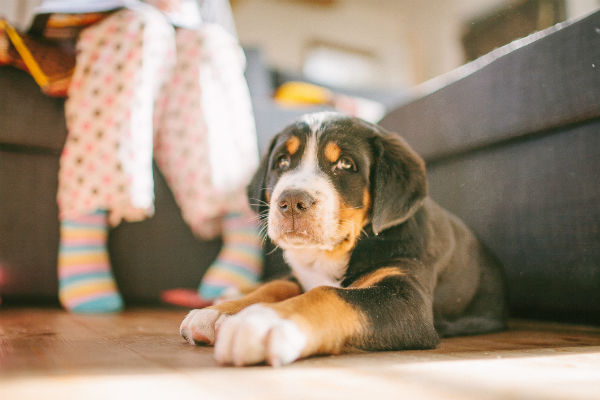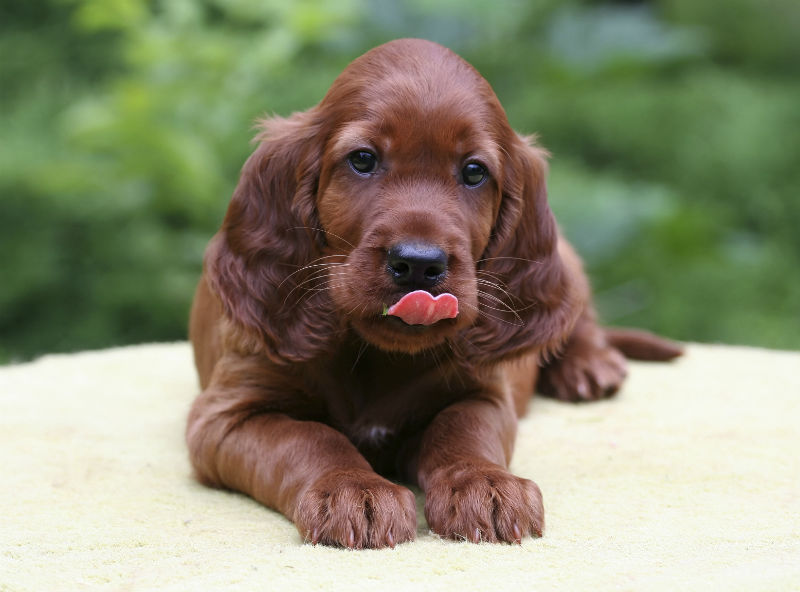| Bringing you puppy home . |
You've chosen a puppy, bought supplies, puppy-proofed your home, and established some household rules. Now it's time to bring your new puppy home. Of course you're excited and eager to start this new bond, but try to imagine what this is like for the puppy. He's just been taken from his mother, siblings, the only humans he knows, and his familiar environment. This can be scary and confusing for a puppy, but there are several things you can do to help him adjust to his new life.
Your first instinct may be to bring him in the house, let him explore and immediately meet his new family. But, take things slowly.
Tips for Bringing Your New Puppy Home

- Choose a potty spot: Start by taking him to the outside area where you want him to go potty. If he does relieve himself, use a command that you'll stick to, like “go potty” or whatever you're comfortable with and remember to praise him.
- Introduce him to his new home: You've already prepared a puppy-proof area of your house, right? This is where you'll bring him. Many people erroneously think they should just let the puppy loose to explore the house at will, but this is a sensory overload. Too many new places, smells, and people at once may just confuse him.
Instead, let him explore a designated area. Perhaps where his food and water are. Or he can familiarize himself with the small, puppy-proofed space where you've placed his crate. Let him get used to this space before you go on further exploratory missions. Then introduce him to the rest of the house, one room at a time, skipping the rooms you've decided are off-limits.
- Introduce him to his new family members: Preferably one person at a time, although this will be difficult with all the excitement about a new puppy. But try to give him a chance to meet each of you quietly.
- Puppies like to chew: Provide appropriate and safe puppy chew toys for him, and if he starts to chew on anything else, redirect him to his chew toy. Here are some other tips about living with a chewing puppy.
- Show him his sleeping place. Puppies sleep between 15-to-20 hours a day, and although they're often likely just to drop in their tracks, bring him to his crate or dog bed when he seems to be ready for a nap and at bedtime. Contrary to what you may think, crates are not “doggie jail.” Dogs prefer the security and safety of a den, and this crate will become his safe place, with some encouragement.
- Keep a close eye on your new puppy. He should be supervised or at least within your vision in his “doggie den” at all times during these early days. Take him with you from room to room, giving him a chance to explore under your watchful eye.
- Start enforcing rules. Although it may seem too early to you, he needs to learn the house rules from the very beginning. The more structured and consistent his day is, the better adjusted and happier he'll be. Whether it's chewing or any other behavior you don't want to encourage, use gentle redirection. Yelling at him or punishing him will only frighten and confuse him, not teach him. Remember that he is only just starting to learn what's expected of him. Praising good behavior and deflecting unacceptable behavior is an effective way of helping him learn.
- Most of all, take things slowly. Gradually expand his environment, under your supervision, of course. With lots of affectionate contact with the family, consistent rules and routine, rewards for good behavior, and gentle corrections for unacceptable behaviors, he'll quickly learn his place in his new “pack.” Not only that but, And most importantly, as he adjusts to his new environment, you will establish a bond that will endure throughout his life.
|
Getting your house ready.
First make a puppy area. Begin by choosing an area of your home in which your puppy will be able to roam safely. Then install puppy or baby gates to enclose the space. ( I like the kitchen because this room is busy so the family can provide lots of interaction with the puppy) .
A large home is too much space for a puppy to roam freely. You want to confine your puppy to an area so you can supervise him. It also help with the potty training. Put away your nice carpet , kids toys, electric extension cords, plants ( a lot of them are poison for puppies) and any little pieces.
What you should have before you pick up your puppy.
**A crate ( I really like the large crate from petedge . ( petedge.com) It comes with a divider so you will only need one .
** Puppy food. ( Ask us what foor we are feeding your puppy. )
** Toys , Lots of chew toys.
** Stainless steel bowl. ( 2 ) One for water and one for the food.
**Treats ( I love the liver treats)you do not need to buy a fancy expensive bed at this time unless your pup is house broken and doesn't chew on everything. You can use some blankets or towels that are easy to wash at first . It will save you some money and time.
**I also really like the chew Nylabone , bully sticks and deer antlers. Very safe for your pup.
Please do not buy Greenies . A Lot of puppies and dogs died from those.
Rawhide bones should be only given under supervision.
**Remember that your puppy is not fully protected from Disease until he had his 3 sets of shots ( 16 weeks old) and I do not recommend bringing him to a Doggy day care , training class and large pet store(before 16 weeks old ). Also If you do bring your pups to Day care or Boarding remember to tell them that Your puppy is growing very fast and that He CANNOT play all day . His hips will thank you for that later on ;) They can play and have fun but not to an excess.
** The feeding schedule of our puppies are
6:30 am
Noon
5:30 pm is their last meal of the day.
|
Online stores that I like shopping,
petdege.com
carealotpet.com
revivalanimal.com
Ebay.com
Lambertvetsupply.com
|
DANGER 10 TOXIC FOODS.
1) Alcohol
2)Chocolate
3)Coffee and anything with caffeine.
4)Garlic
5)Grapes
6)Macadamia nuts
7)Onions
8) Raisins
9)Tea
10)Yeast dough.
Animal poison Control center's 24 hour hotline: 1-888-426-4435
|
|
Poisonous Plants- Dogs and Cats
Amarylillis
Apple Leaf Croton
Autumn Crocus
Avacado (fruit and pit)
Azalea
Baby's Breath
Bittersweet
Bird of Paradise
Branching Ivy
Buckey
Buddist Pine
Caladium
Calla Lily
Castor Bean
Ceriman
Charming Dieffenbachia
Chinese Evergreen
Christmas Rose
Cineraria
Clematis
Cordatum
Corn Plant
Cornstalk Plant
Croton
Cuban Laurel
Cutleaf Philodendron
Cycads
Cyclamen
Daffodil
Devil's Ivy
Dianthus
Dieffenbachia
Dracaena Palm
Dragon Tree
Dumb Cane
Dianthus
Easter Lily (in cats!!!!)
Elaine
Elephant Ears
Emerald Feather
English Ivy
Fiddle-leaf fig
Florida Beauty
Foxglove
Fruit Salad Plant
Geranium
German Ivy
Giant Dumb Cane
Glacier Ivy
Gold Dieffenbachia
Gold Dust Dracaena
Golden Pothos
Hahn's Self-Branching Ivy
Heartland Philodendron
Hops
Hurricane Plant
Indian Rubber Plant
Janet Craig Dracaena
Japanese Show Lily (cats !!!)
Jeusalem Cherry
Kalanchoe
Lacy Tree Philodendron
Lily of the Valley
Madagascar Dragon Tree
Marble Queen
Marijuana
Mexican Breadfruit
Miniature Croton
Mistletoe
Morning Glory
Mother-in Law's Tongue
Narcissus
Needlepoint Ivy
Nephytis
Nightshade
Oleander
Onion
Oriental Lily (cats!!!)
Peace Lily ( One family called us telling us that their pup only took a bite of the plant and got very very sick. Spent 2 days at the er )
Pencil Cactus
Plumosa Fern
Poinsettia (low toxicity)
Poison Ivy
Poison Oak
Pothos
Precatory Bean
Primrose
Red Emerald
Red Princess
Red-Margined Dracaena
Rhododendron
Ribbon Plant
Saddle Leaf Philodendron
Sago Palm
Satin Pothos
Schefflera
Silver Pothos
Spotted Dumb Cane
Stargazer lily (cats!!!)
String of Pearls
Striped Dracaena
Sweetheart Ivy
Swiss Cheese Plant
Taro Vine
Tiger Lily (cats!!!)
Tobacco
Tree Philodendron
Tropic Snow Dieffenbachia
Weeping Fig
Yew
* please note: this list is not all inclusive
|
|

